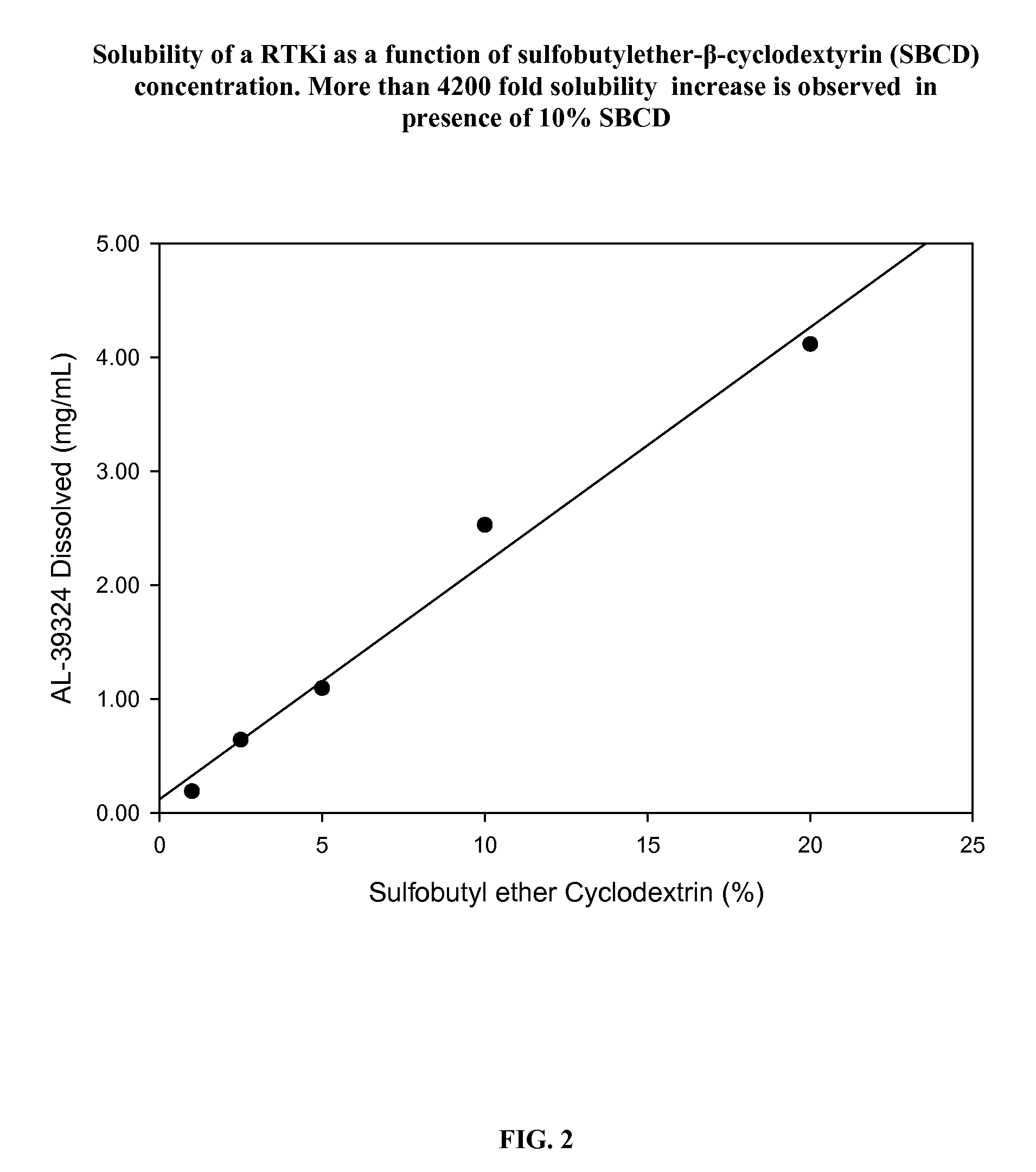PHARMACEUTICAL COMPOSITION FOR DELIVERY OF RECEPTOR TYROSINE KINASE INHIBITING (RTKi) COMPOUNDS TO THE EYE
a technology of receptor tyrosine kinase and pharmaceutical composition, which is applied in the direction of heterocyclic compound active ingredients, applications, biocide, etc., can solve the problems of irreversible vision loss, severe vision loss, and disruption of the organizational structure of the neural retina,
- Summary
- Abstract
- Description
- Claims
- Application Information
AI Technical Summary
Benefits of technology
Problems solved by technology
Method used
Image
Examples
example 1
[0039] This example illustrates the preparation of Intravitreal formulation vehicle containing hydroxypropyl-β cyclodextrin (HPCD).
IngredientAmount (w / v, %)Polysorbate 800.1Hydroxypropyl-β-Cyclodextrin10Dibasic Sodium Phosphate, Dodecahydrate0.18Viscosity enhancer0.05Sodium Chloride0.55Hydrochloric acidq.s. to pH 7.2Sodium Hydroxideq.s. to pH 7.2Water for Injectionq.s. to 100
[0040] In a 150 mL glass container, was added 9 g sterile 2% dibasic sodium phosphate, dodecahydrate solution. To it was added 10 g hydroxypropyl-β cyclodextrin and stirred for about 30 min. To it was added 5 g sterile 2% polysorbate 80 solution, 2.5 g of sterile 2% stock HPMC 2910 (E4M) solution and 11 g of 5% sterile sodium chloride solution, and stirred well until homogeneous. Sterile water for injection was added to get to 95% of batch size. The solution was stirred at RT for 30 min and pH was adjusted to 7.2. Finally, water for injection was added to get final batch of 100 g.
example 2
[0041] This example illustrates the preparation of RTKi (N-[4-(3-amino-1H-indazol-4-yl) phenyl]-N′-(2-fluoro-5-methylphenyl) urea) Intravitreal Formulation containing hydroxypropyl-β cyclodextrin (HPCD).
IngredientAmount (w / v, %)RTKi1Polysorbate 800.1Hydroxypropyl-β-Cyclodextrin10Dibasic Sodium Phosphate, Dodecahydrate0.18Viscosity enhancer0.05Sodium Chloride0.55Hydrochloric acidq.s. to pH 7.2Sodium Hydroxideq.s. to pH 7.2Water for Injectionq.s. to 100
[0042] In a 250 mL glass container, carefully weigh 1 g sterile RTKi raw material. To it was added 20 g of 0.5% Polysorbate 80 solution. The suspension was ball milled for 8 h using Zirconia beads. Upon completion of ball milling, the suspension was filtered through a Buchner funnel; beads were washed thoroughly with water. To it was added 9 g sterile 2% dibasic sodium phosphate, dodecahydrate solution and 10 g hydroxypropyl-β cyclodextrin. The solution was stirred for about 30 min. To it were added 2.5 g of sterile 2% stock HPMC 2910...
example 3
[0043] This example demonstrates the preparation of RTKi (N-[4-(3-amino-1H-indazol-4-yl) phenyl]-N′-(2-fluoro-5-methylphenyl) urea) formulation for PJ and / or periocular use.
IngredientAmount (w / v, %)RTKi3Polysorbate 800.3Hydroxypropyl-β-Cyclodextrin15Dibasic Sodium Phosphate, Dodecahydrate0.18Viscosity enhancer0.2Sodium Chloride0.5Hydrochloric acidq.s. to pH 7.2Sodium Hydroxideq.s. to pH 7.2Water for Injectionq.s. to 100
[0044] In a 250 mL glass container, carefully weigh 3 g sterile RTKi raw material. To it was added 30 g of 1% Polysorbate 80 solution. The suspension was ball milled for 8 h using Zirconia beads. Upon completion of ball milling, the suspension was filtered through a Buchner funnel; beads were washed thoroughly with water. To it was added 4.5 g sterile 4% dibasic sodium phosphate, dodecahydrate solution and 15 g hydroxypropyl-β cyclodextrin. The solution was stirred for about 30 min. To it were added 10 g of sterile 2% stock HPMC 2910 (E4M) solution and 11 g of 5% st...
PUM
| Property | Measurement | Unit |
|---|---|---|
| Fraction | aaaaa | aaaaa |
| Fraction | aaaaa | aaaaa |
| Fraction | aaaaa | aaaaa |
Abstract
Description
Claims
Application Information
 Login to View More
Login to View More - R&D
- Intellectual Property
- Life Sciences
- Materials
- Tech Scout
- Unparalleled Data Quality
- Higher Quality Content
- 60% Fewer Hallucinations
Browse by: Latest US Patents, China's latest patents, Technical Efficacy Thesaurus, Application Domain, Technology Topic, Popular Technical Reports.
© 2025 PatSnap. All rights reserved.Legal|Privacy policy|Modern Slavery Act Transparency Statement|Sitemap|About US| Contact US: help@patsnap.com



